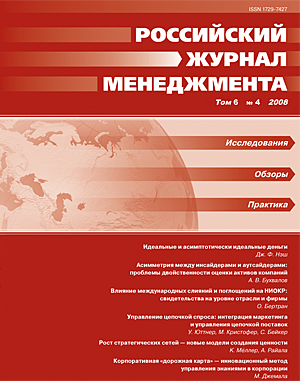Асимметрия между инсайдерами и аутсайдерами: проблемы двойственности оценки активов компаний
Аннотация
Работа посвящена изучению модификации модели ценообразования на капитальные активы (CAPM), учитывающей различия между инсайдерами — агентами, реально влияющими на управленческие решения в компании, и аутсайдерами, к которым мы относим всех акционеров, существующих и потенциальных, которые не могут активно влиять на управленческие решения. Данный подход существенно обобщает известную агентскую проблему: центральным моментом становится не информационная асимметрия, а институциональная асимметрия, связанная с доступом к управлению. Если традиционная агентская проблема в своей классической постановке требует издержек от компании, а тем самым уменьшает и ее ценность для всех видов акционеров, то при нашей постановке возможны и положительные эффекты. Предлагаемая модель представляет собой новую интерпретацию известной модели Д. Мейерса ценообразования на рынке капитала, где имеются неторгуемые активы, приносящие недетерминированный доход. В качестве неторгуемых активов мы рассматриваем активы компании, создаваемые или разрушаемые в результате активных действий инсайдеров. В силу вхождения в модель ряда параметров, которые непосредственно не наблюдаемы и могут быть моделируемы только с помощью небесспорных прокси, в литературе практически неизвестны успешные эмпирические исследования, основанные на данной модели. В этой работе мы показываем влияние на ценность компаний существования неторгуемого актива в принципе. В работе сформулирован ряд постановок задач, требующих своего дальнейшего развития. На основе модели сделаны выводы о стратегических решениях инвесторов, в частности в области диверсификации.
Ключевые слова:
CAPM, неторгуемые активы, оценивание, двойственность оценки активов, корпоративное управление, реальные опционы
Скачивания
Библиографические ссылки
REFERENCES IN LATIN ALPHABET
Загрузки
Опубликован
Как цитировать
Выпуск
Раздел
Лицензия
Статьи журнала «Российский журнал менеджмента» находятся в открытом доступе и распространяются в соответствии с условиями Лицензионного Договора с Санкт-Петербургским государственным университетом, который бесплатно предоставляет авторам неограниченное распространение и самостоятельное архивирование.





